Dental implants are increasingly gaining recognition as a leading solution for missing teeth. But what are dental implants? They serve as artificial tooth roots, designed to provide a strong foundation for replacement teeth. As a sophisticated dental solution, they combine technology with an understanding of oral health to enhance one’s quality of life.
What Are Dental Implants?
Before diving into the various types of dental implants, it’s essential to understand the very concept of dental implants themselves.
Definition
A dental implant is a titanium (or sometimes zirconia) post that replaces the root of a missing tooth. Once surgically placed in the jawbone, it acts as a strong foundation for a crown, bridge, or full arch. The beautiful aspect of dental implants is that they mimic the look, feel, and function of a natural tooth, making them an optimal choice for both aesthetics and functionality.
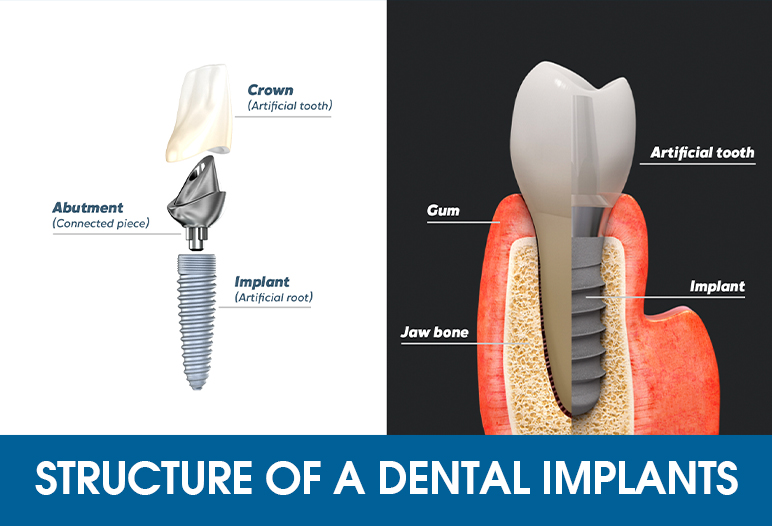
Long-Term Solution with High Success Rate
Dental implants are considered a long-term solution for tooth loss. With a high success rate of up to 98%, they offer durability that stands the test of time, transforming how we approach the issue of missing teeth. Individuals who’ve undergone the procedure often report enhanced self-confidence, improved chewing efficiency, and an overall boost in life quality.
The Role in Oral Health
Beyond aesthetics, dental implants play a crucial role in maintaining oral health. When a tooth is lost, the jawbone can deteriorate—a process known as bone loss. Dental implants can stop this deterioration by integrating with the bone, a process known as osseointegration. This ensures that not only does one regain their smile, but they also preserve the structure of their jaw over time.
What Are the 3 Types of Dental Implants?
In the world of dental implants, there is no “one-size-fits-all” approach. The type of implant used will depend on the individual needs of the patient and the condition of their oral health.
Endosteal Implants
Endosteal implants are the most common type and are typically inserted directly into the jawbone.
- Design and Structure: These implants are usually shaped like small screws. Once in place, an abutment is attached on top to help hold the final restoration—a crown, bridge, or denture.
- Ideal Candidates: Patients with a healthy jawbone and sufficient bone density are ideal candidates for endosteal implants. The success of this type relies heavily on the stability of the jawbone.
- Procedure Involved: The process generally involves a surgical procedure where the implant is placed surgically and then left to heal and integrate with the bone over several months before the final restoration is added.
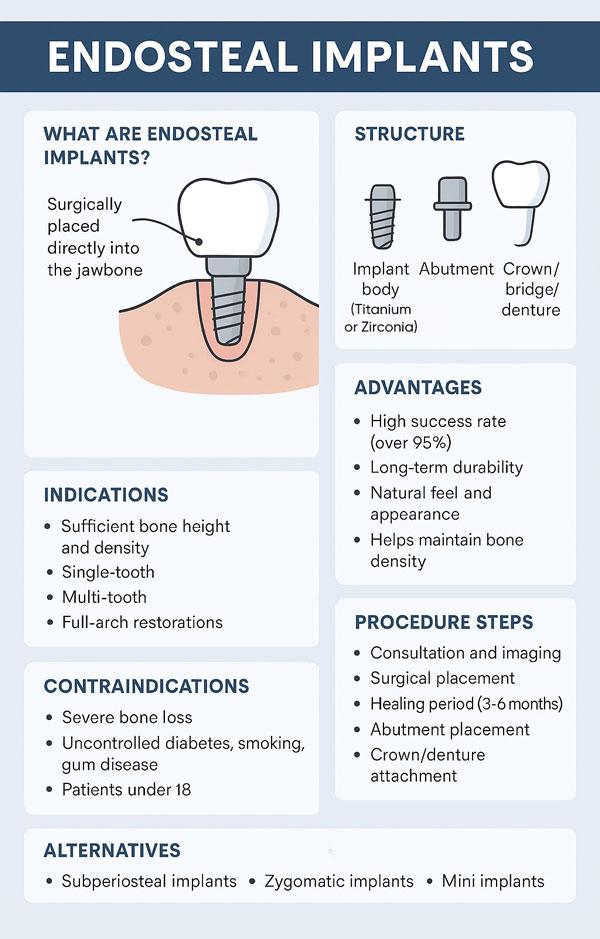
Subperiosteal Implants
For patients with less available bone but still wanting an implant, subperiosteal implants come into play.
- Positioning and Design: Unlike endosteal implants, subperiosteal implants are placed under the gum but above the bone. They consist of a metal framework that protrudes through the gums to hold the prosthetic teeth.
- Best Suited For: These implants are best suited for patients who may not be candidates for endosteal implants due to bone loss but do not want more invasive procedures to augment their bone.
- Considerations: Nevertheless, the stability of the prosthetic teeth can vary based on how well the subperiosteal framework bonds with the bone beneath.
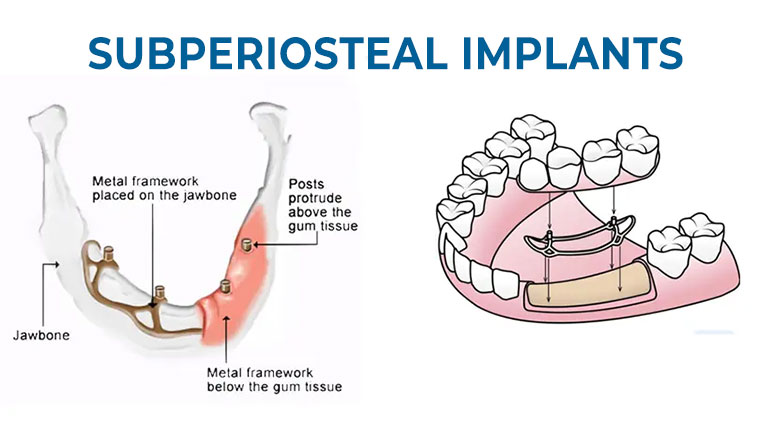
Zygomatic Implants
Rarely performed but highly effective for specific cases are zygomatic implants, which are anchored into the cheekbone.
- Purpose and Usage: These implants are utilized primarily for patients with severe bone loss in the upper jaw but who wish to avoid bone grafting surgeries.
- Advantages: The key advantage is that they provide a stable base for dental prosthetics without requiring additional surgical intervention to strengthen the jaw.
- Risks and Limitations: However, due to their complexity, the placement of zygomatic implants is usually reserved for highly experienced dental professionals.
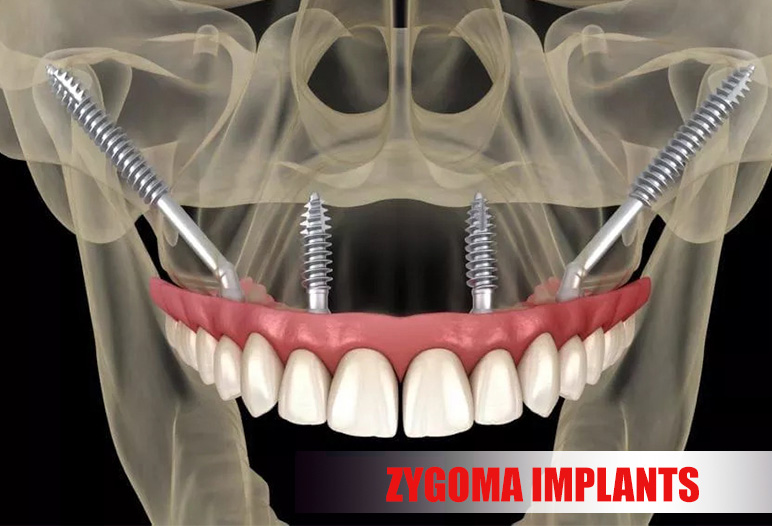
What Are Screwless Dental Implants?
While most traditional dental implants involve screws, a different approach exists for those seeking an alternative: screwless dental implants.
Definition
Screwless dental implants avoid the use of screws for retaining the prosthetic teeth. Instead, they employ cement or friction-fit designs that offer advantages and disadvantages compared to their screw-retained counterparts.

Aesthetic Benefit
One of the significant selling points for screwless implants is the aesthetic benefit. There’s no visible screw hole, making the restoration look more like a natural tooth.
- Patient Perspective: Many patients prefer this option for cosmetic reasons and feel more confident about their appearance.
- Maintenance: However, if the prosthetic needs to be removed for any reason, it can be more challenging to access and repair, possibly complicating future dental care.
When They Might Be Recommended
Screwless implants may be recommended in specific circumstances, particularly when a patient prioritizes aesthetics over the ease of maintenance.
- Consultation Requirements: A thorough consultation with a dental professional who specializes in dental implants is critical for determining whether screwless implants are suitable for an individual’s unique needs.
The Dental Implants Process: Step-by-Step
Understanding the implants process is paramount for anyone considering dental implants. Below is a detailed breakdown of each step involved, ensuring you’re well-prepared for what lies ahead.
Consultation & 3D Imaging
The journey begins with an initial consultation where your dentist will evaluate your oral health.
- Imaging Techniques: This often includes 3D imaging to provide a comprehensive view of your jawbone structure, allowing for a thorough assessment.
- Personalized Treatment Plan: Based on the imaging and your dental health, a customized treatment plan will be developed, which may include additional procedures like a bone graft for tooth implant if bone loss is detected.
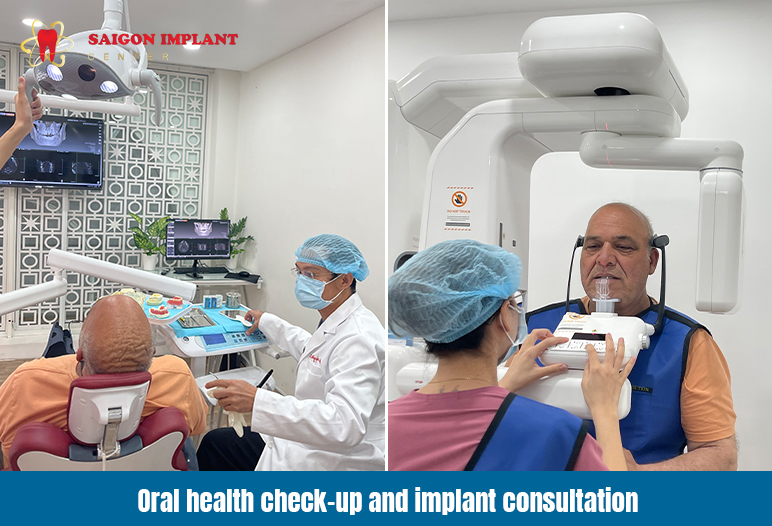
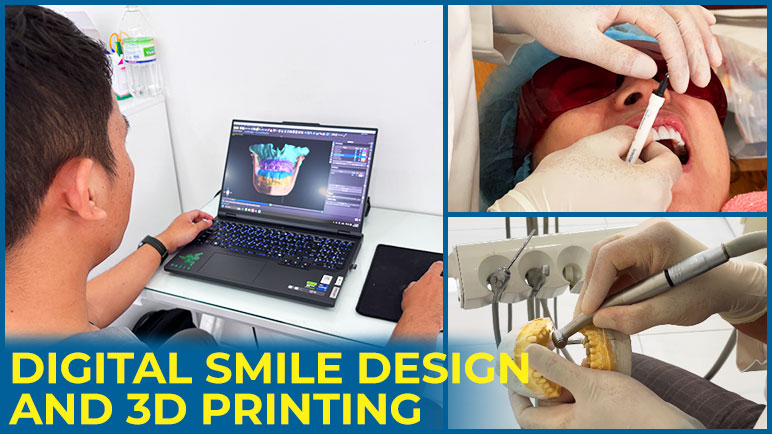
Tooth Extraction (if necessary)
If any teeth need to be removed before the implant procedure, this step takes place next.
- Healing Timeline: After extraction, allow time for healing as the mouth adjusts before proceeding with implant placement, which may be a few weeks or months.
- Importance of Healing: Adequate healing is vital for ensuring successful osseointegration, where the implant integrates smoothly with the surrounding bone.
Bone Graft for Tooth Implant (if bone loss is present)
A bone graft may be necessary if there is insufficient bone density to support the implant.
- Procedure Overview: This involves placing bone material in the jaw to encourage new bone growth. This process can take several months, during which the transplanted bone becomes integrated into your jaw.
- Long-Term Stability: This foundational step is critical for long-term implant stability, ensuring successful implant placement.
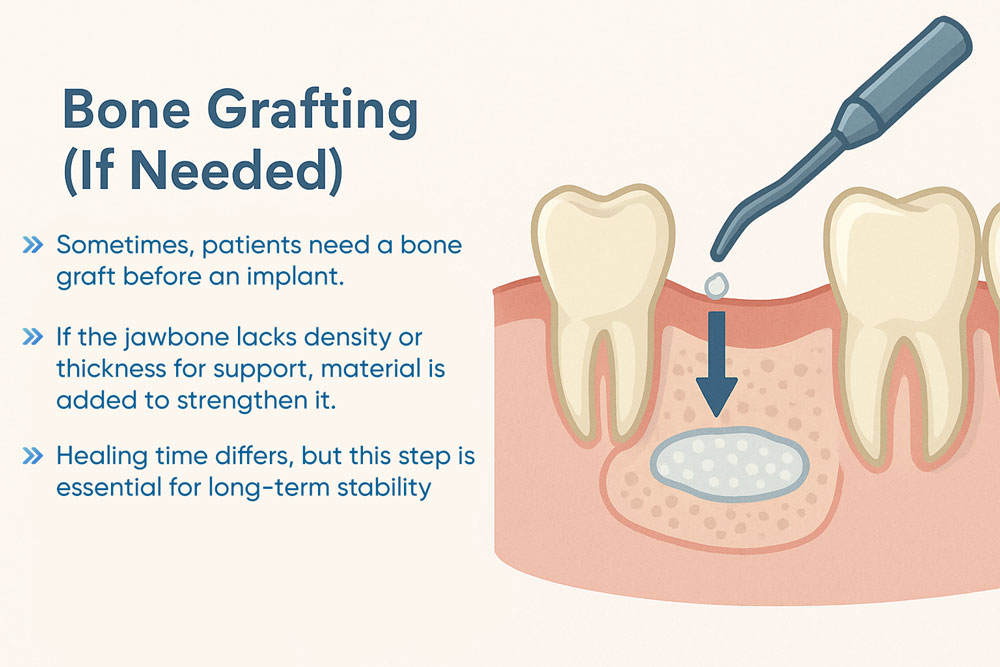
Implant Placement Surgery
The moment of truth arrives with the implant placement surgery.
- Surgical Procedure: Under local anesthesia, the dental implant is surgically placed into the jawbone, where it will serve as the new root for the replacement tooth.
- Post-Surgery Care: After the procedure, proper care and pain management will be discussed to ensure a smooth recovery.
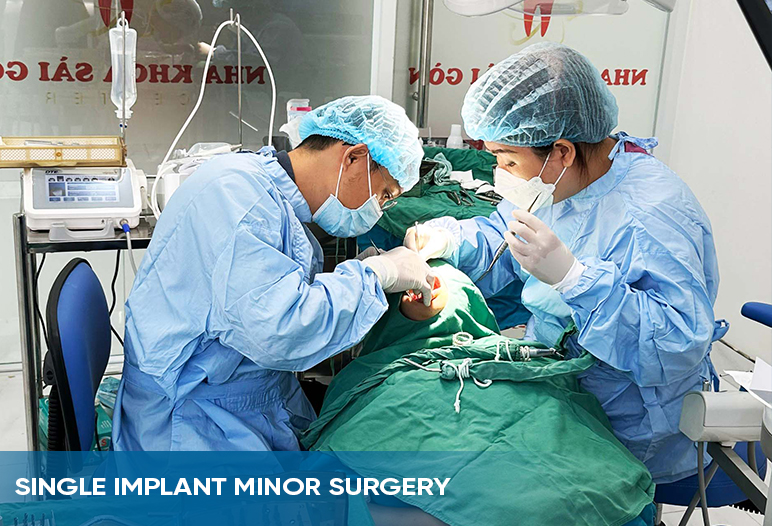
Healing Period (Osseointegration) – 3–6 months
Post-surgery, the healing period is crucial for osseointegration.
- Understanding Healing: The 3-6 month healing period allows the bone to grow around the implant, securing it firmly.
- Follow-Up Appointments: Regular follow-up appointments with your dentist during this period are essential to monitor healing and resolve any concerns.
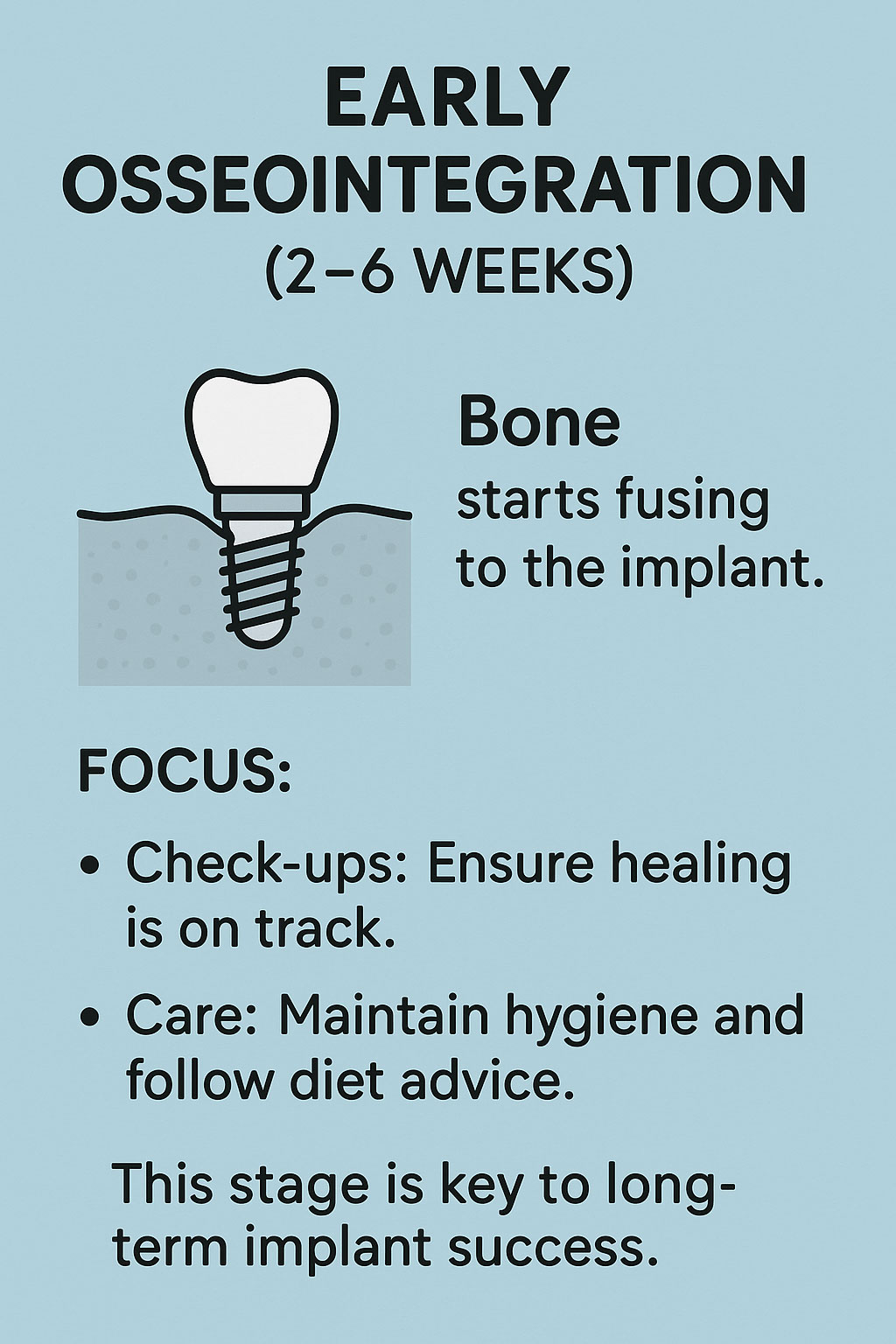
Abutment & Crown Placement
Once osseointegration is complete, the next appointment will involve placing an abutment.
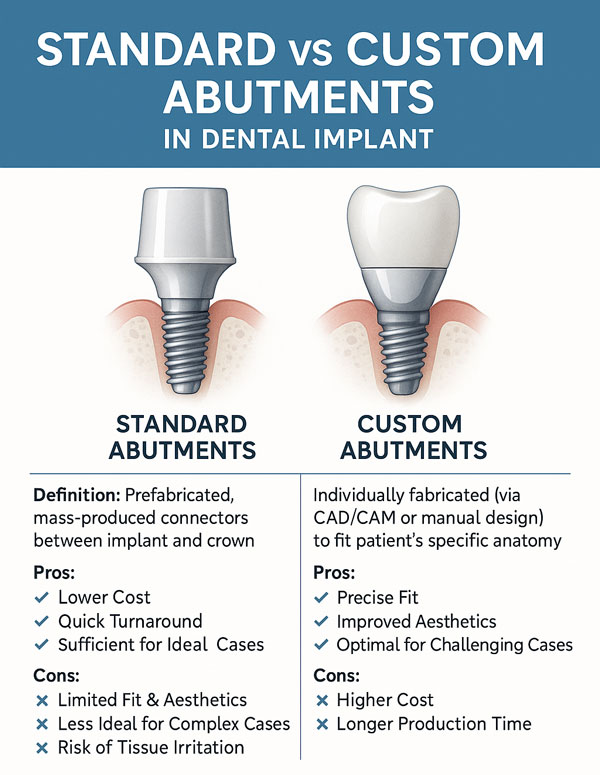
- What Is an Abutment?: The abutment extends above the gum line and serves as the connector between the implant and the final crown.
- Artistry in Crowns: A crown, custom-designed to match your natural teeth, is then attached to the abutment, fully restoring your smile.
Final Check and Maintenance Plan
Finally, regular check-ups and a maintenance plan will be established.
- Importance of Maintenance: It is crucial to maintain oral hygiene and receive regular dental visits to ensure the longevity of the implants.
- Adjustment Period: Keep in mind that it may take a little while to adjust fully to the new prosthetic tooth, but soon it will feel like a natural part of your mouth.
Full Mouth Dental Implants
For individuals who have lost all their teeth in the upper and/or lower jaw, full mouth dental implants provide a comprehensive solution.
Ideal for Patients Missing All Teeth
Completing a full arch replacement can dramatically change one’s smile and functionality.
- Complete Restoration: Full mouth dental implants allow for a fixed, non-removable solution that greatly differs from traditional dentures.
- Enhanced Quality of Life: Studies have shown that individuals with full mouth implants report greater satisfaction with their smiles and dental function.
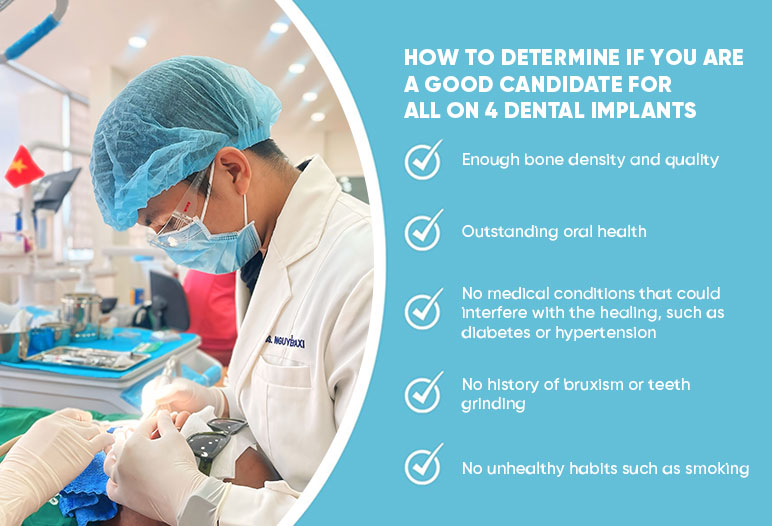
Common Methods
There are various methods for achieving full mouth restoration; among the most popular are:
- All-on-4 / All-on-6 Implants: These methods use just four or six strategically placed implants to support an entire arch of prosthetic teeth.
- The advantage here is that the approaches require less bone density than traditional implants, thus minimizing the need for extensive bone grafting.
- Implant-Supported Dentures: These offer another solution where snap-on dentures rest on the dental implants, providing stability without a full arch restoration.
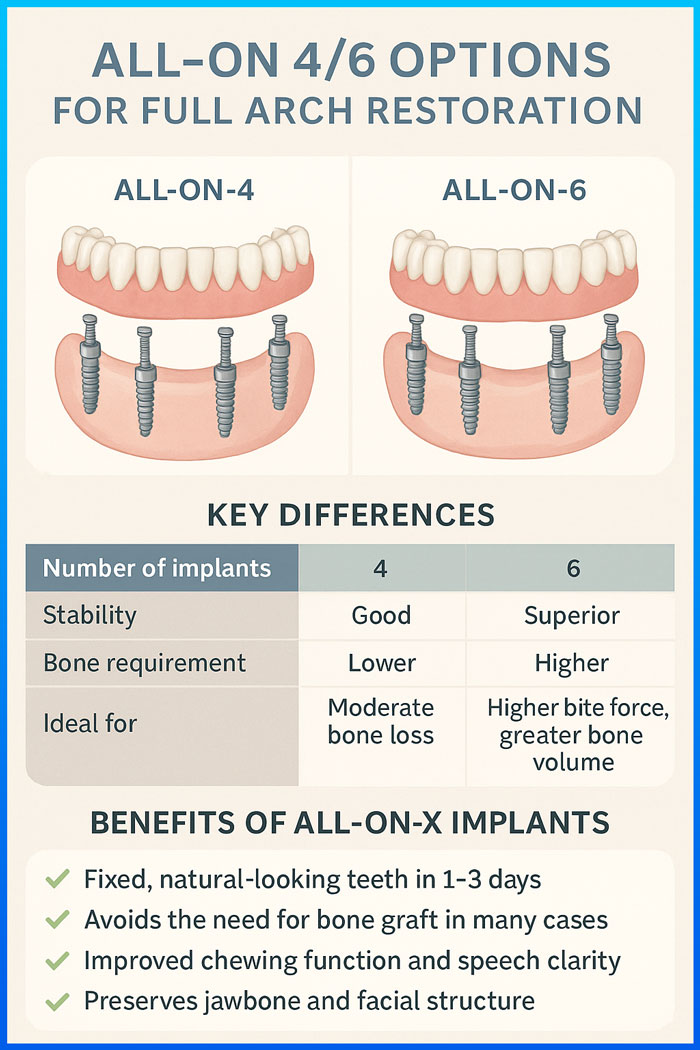
Benefits Over Traditional Dentures
Compared to traditional dentures, full mouth implants offer significant advantages.
- Stability and Comfort: There is significantly less movement compared to traditional dentures, which can result in enhanced comfort during eating and speaking.
- Bone Preservation: Implants help maintain and stimulate the jawbone, preventing the resorption that occurs with missing teeth.
- Longevity: With proper care, full mouth implants can last decades, offering one of the best long-term solutions for missing teeth.
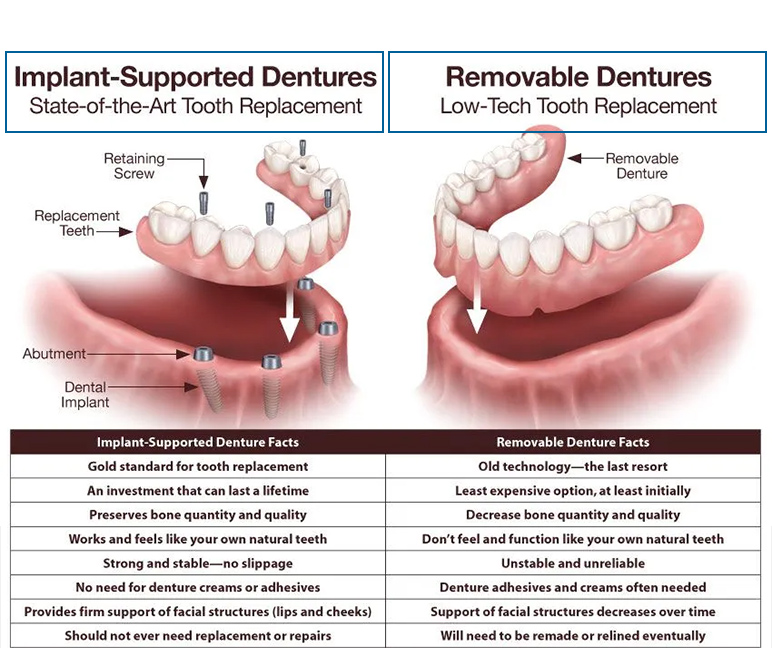
Cost and Time Considerations
While full mouth implants can come with a higher initial cost compared to traditional methods, they certainly provide exceptional long-term value.
- Cost Evaluation: Patients should consult with dental professionals for personalized quotes, which will consider individual treatment needs.
- Timeframe Assessment: The treatment timeline is generally longer than traditional dentures due to surgical steps and the healing period needed for osseointegration.
Who Is a Good Candidate for Dental Implants?
Before proceeding with dental implants, understanding who qualifies is essential for successful outcomes.
Healthy Gums and Sufficient Bone
Good candidates typically exhibit healthy gums and the requisite bone density.
- Importance of Bone Density: Sufficient bone ensures stable placement of the implants, as bone deficiency can lead to failure.
- Gum Health: Healthy gums minimize the risk of infection, which is crucial for maintaining the integrity of the implant.
Non-Smoker or Willing to Quit
Smoking can lead to complications during healing and increase a higher risk of failure.
- Commitment to Change: Candidates are usually advised to quit smoking if they wish to proceed with dental implant procedures significantly.
- Post-Procedure Recovery: Smoking can hinder blood flow, which is essential for healing after surgery.

No Uncontrolled Diabetes or Serious Systemic Diseases
Individuals with certain systemic conditions, such as uncontrolled diabetes or other systemic issues, may face challenges.
- Consultation Necessity: A thorough consultation will help assess these risks, ensuring a tailored treatment plan.
- Ongoing Health Monitoring: Comprehensive health checks are essential for individuals looking to undergo such procedures.
Commitment to Oral Hygiene
Lastly, candidates should be committed to maintaining proper oral hygiene practices.
- Importance of Vigilance: It’s crucial for preserving the health of the implants and surrounding tissues.
- Routine Maintenance: Regular dental visits are paramount for monitoring and maintaining oral health post-procedure.
Pros and Cons of Dental Implants
As with any medical procedure, dental implants come with their set of advantages and disadvantages.
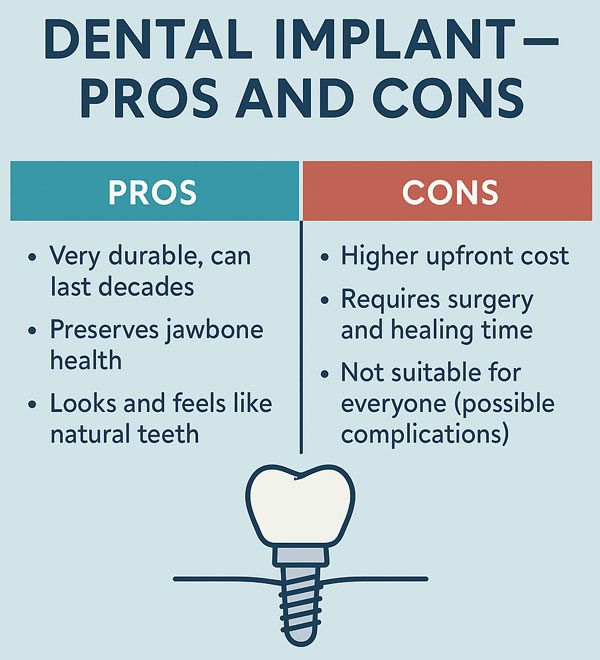
Pros
The benefits of dental implants are substantial:
- Long-lasting: Typically, they can last for decades, making them a long-term investment in oral health.
- Natural Look and Function: They closely mimic natural teeth, enhancing aesthetics and functionality.
- Prevents Bone Loss: By stimulating the jawbone, dental implants help to prevent the bone deterioration that often follows tooth loss.
- Boosts Self-Esteem: Feeling confident in one’s smile can have profound psychological benefits.
Cons
However, it is essential to consider the downsides:
- Higher Upfront Cost: Generally, dental implants can involve a larger financial commitment upfront compared to traditional dentures.
- Requires Surgery and Healing Time: Surgical intervention means some risks are involved, and the healing process can take several months.
- Potential for Bone Grafting: Those with bone loss may require additional procedures, such as a bone graft for tooth implants, adding complexity.
Conclusion
In summary, what are dental implants? They are innovative, life-changing solutions for those dealing with missing teeth. Through various types of implants, personalized approaches, and a step-by-step process, they represent a versatile, durable, and natural-looking alternative for teeth restoration. If you are considering dental implants, take the first step toward restoring your smile by consulting a dentist who can assess your eligibility and guide you through the journey.

 Google Reviews
Google Reviews Call
Call
SAIGON IMPLANT CENTER
Best dentist in Vietnam
Saigon Implant Center - Dental Clinic utilizes the latest technology for specialized treatment in the field of Single implant, full jaw implants, All on 4 implants, All on 6 implants, Zygoma implant....
SAIGON IMPLANT CENTER
Best dentist in Vietnam
Saigon Implant Center - Dental Clinic utilizes the latest technology for specialized treatment in the field of Single implant, full jaw implants, All on 4 implants, All on 6 implants, Zygoma implant....